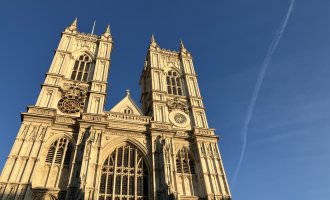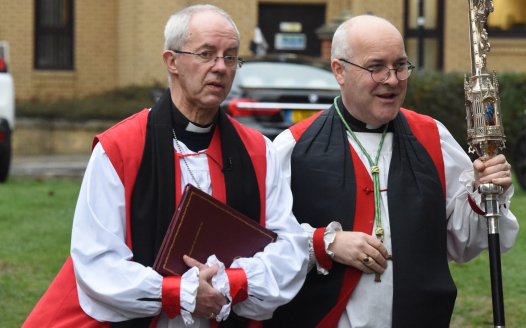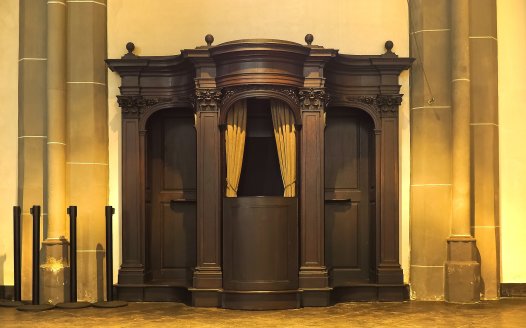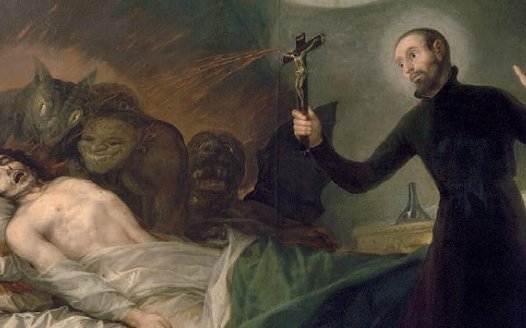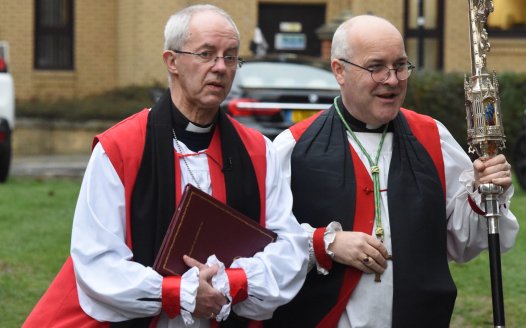Church of England’s links with insurer undermines justice for survivors of clergy abuse
Posted: Wed, 26th Jul 2017 by Keith Porteous Wood
Anglican abuse victims believe the Church's close links with its insurer results in lower settlements to victims. NSS executive director Keith Porteous Wood thinks they've got a point, and offers solutions to put things right.
An insurance company connected with the Church of England has been accused by abuse survivors of having unreasonably resisted financial settlements because it has too close an association with the Church itself.
Teresa Cooper and Gilo (surname withheld at his request) made the case powerfully on the BBC's Victoria Derbyshire programme on Friday 21 July (recording starts 14 minutes in).
The painstaking and revealing research carried out by these survivors demonstrates why the close relationship between the CofE and Ecclesiastical Insurance Group (EIG) will tend to suppress the level of settlements and makes the already difficult process of obtaining compensation for victims even harder. The Church of England founded EIG and remains affiliated to it.
The Anglican Church receives massive grants - a dividend in all but name - from EIG through the charity Allchurches Trust. For the period 2014-2020 this is likely to amount to around £100 million, according to the research of these survivors.
Another concern is the numerous bishops and cathedral deans and head teachers of schools with abuse problems that have been directors on EIG's board. They sit in a non-executive capacity despite being experts neither on insurance nor, as far as we are aware, on any other corporate area. The question is: why are they there and what effect does their presence have on payouts to abuse victims?
EIG failed in the TV programme to justify the CofE cleric's presence on its board. It claimed it was "normal business practice because the Church of England was one of its major customers". This ruse fails closer examination. It is not normal practice for companies to invite representatives of major customers (perhaps in competition with each other) onto their boards, if for no other reason than that those so invited would become privy to commercial secrets and sensitive intelligence that could then be used to the detriment of the supplier or competitor. Clearly there has to be another reason. Let us not forget the massive grant; the Church of England certainly has a vested interest – the smaller the abuse settlements are, the greater the grant they will receive.
Insuring against abuse claims – which, I maintain, the Church does not need to do – enables it to distance itself from the potentially manipulative business of these sensitive settlements being negotiated behind someone else's closed doors.
Facing such confrontations would be difficult for anyone, but in my experience most victims are vulnerable and damaged because of the abuse they have suffered. The inevitable confrontation with lawyers representing insurance companies compounds that abuse.
Victims may have to pursue justice – including compensation - alone and without support. Rather than help the victims through this ordeal, the Church of England has been accused in a BBC report by a survivor of withdrawing emotional support for the abused.
The Bishop of Buckingham, Alan Wilson, was refreshingly open on the Victoria Derbyshire programme. He agreed that legal and pastoral roles were in conflict over the settling of survivors' claims and the Church should be concentrating on the latter.
Gilo's shocking case made headlines last year – Church of England figures ignored 'sadistic' abuse of 15-year-old boy by senior priest for 40 years and 'I told so many bishops': survivor tells of system that protected priest.
As if that were not bad enough, Gilo told me that as soon as mention of legal and settlement process was made, lawyers acting on behalf of the insurer instructed Bishop Paul Butler and the Church to cut all contact with him, including emotional support or pastoral care. Gilo blames the close Church-insurer link, as does international child safeguarding expert Ian Elliott, who prepared a highly critical review of this case. Mr Elliott told the Victoria Derbyshire programme that he is convinced that there is a conflict between the insurer's advice and the responsibilities of the Church.
Teresa Cooper has spent her whole adult life campaigning bravely and relentlessly for truth and justice for the Church of England abuse victims. She has done so despite being repeatedly ignored by the Church. She has faced cover-ups and dishonest denials by a bishop and the Church as well as the county's social services department – which was run by a vicar.
It is clear from hearing her speak what a huge toll the dreadful abuse she suffered as a vulnerable youngster has exacted on her, ruining many aspects of her life. Teresa was a resident in the CofE's Kendall House home for girls in Gravesend, Kent. According to this BBC report girls, some as young as 11, "were routinely drugged, locked up and physically, emotionally and sexually abused"for decades. Some, including Ms Cooper, went "on to have children with birth defects after being forcibly given cocktails of drugs" - in her case reportedly over a thousand times.
Teresa struggled for decades to raise public awareness about Kendall House. It was not until 2007 that she was summoned to a meeting with the Church. She was required to give an account of her abuse alone and without support, having to face three men including a representative of the insurer Ecclesiastical and the then Bishop of Rochester, Michael Nazir-Ali. She says he "proceeded to discredit and undermine my story directly in front of the insurer. In effect, he called me a liar and said there were no drugs used at Kendall House, which was astonishing". Drugs were rampant there, as the Kendall House review later made clear.
Predictably, no compensation was forthcoming. Probably assisted by an appearance on the Today programme in 2009, she agreed an out-of-court settlement in 2010 with the Church of England - 25 years after leaving Kendall House. Despite everything she had suffered, and the Church's disgraceful record of dealing with it, including wanton cruelty, the Church characteristically refused to accept liability even for this open and shut case.
Teresa continues her search for justice. Just this month she unearthed archive footage at the British Library providing further corroborative evidence of the abusive regime at Kendall House, and reported by the BBC.
The Rev. Nicolas Stacey was an innovative Director of Social Services for Kent County Council from 1974-1985. He said, presumably referring to the services in Kent for which he was responsible, which didn't include the Church-run Kendall House: "Nobody was to go to the police about accusations against staff without my approval". He never reported staff to the police, "because I never felt that we had a serious case". ... It was "incredible the way times have changed - I could never begin to do that now". ... [It's] "terribly sad if you're sexually orientated towards children, you know". In 2005, the Rev Nicholas Stacey was awarded the Cross of St Augustine, given personally by the Archbishop of Canterbury "for outstanding service within the Church of England".
The author of the Kendall House review contacted Teresa after the BBC report describing the revelations about Stacey as "appalling".
Dr Nazir-Ali was on the Archbishops' Council and champion of traditional Christianity in Britain, but did not see fit to even mention Kendall House to his successor as Bishop of Rochester, who to his credit commissioned the Review into Kendall House which describes its own findings as "harrowing".
The most shocking aspect of the recently released independent review on historic abuse by jailed ex-bishop Peter Ball was the demonstration of the established Church's power to prevail upon all arms of the justice system to collude in shielding what they even then knew to be a renegade bishop from trial for twenty years, which also led to a suicide. It provides page upon page of evidence which shows that in so many cases the more senior the cleric, the worse their record appears to be on shielding abusers and resisting the claims of their victims. It admits that "The Church [of England], at its most senior levels and over many years, supported [perpetrator Ball who had been abusing for over forty years before being imprisoned] unwisely and displayed little care for his victims". … "The failure to pass six of the letters to police … must give rise to a perception of deliberate concealment." Richard Scorer, a specialist abuse lawyer at Slater and Gordon, who represents a number of Ball's victims, added: "It's clear that senior figures concealed very serious allegations against Ball - the institution colluded with an abuser."
One of Ball's victims, Rev Graham Sawyer, told the media last year he refused to participate in the review because the "bullying and silencing" he experienced as a result of his disclosures was not included in the [review's] remit. Whether it was or not, this crucial issue was barely touched on in the review, despite representations specifically about bullying and silencing which the National Secular Society made to the chair at the outset. I have seen both a lengthy account of that bullying of Graham Sawyer over decades and seen it in action quite recently. And I know he is not alone in being bullied in this way.
And that review was just about one, albeit especially high profile, abuser with probably over a hundred victims, most of whom were abused numerous times. Let us not forget that there are many more, including a number in the pipeline.
I acknowledge and welcome new administrative structures that have been set up and more resources have been devoted to combating abuse. They are essential, but will be largely ineffective unless the culture at all levels is supportive and there is determination from the top to drive this through without fear or favour.
If only that were the case.
Gilo "attempted to alert Justin Welby on 17 occasions, both in writing and by telephone, but was persistently ignored, causing further pain and trauma". His is not an isolated case. Some examples of those highlighted last year include: Senior Anglican clergy (including Archbishop of York) accused of failing to act on rape allegations; Church of England clergyman found guilty of historical sex offences (known about by the then Bishop of Durham); and Ex-Archbishop quits over CofE child sex allegations. According to a press report last year "The police are considering an investigation into the former Archbishop of York" in connection with this.
The police involvement was likely to have been prompted by a formal investigation by Judge Sally Cahill, QC, which contained devastating criticisms of the former Archbishop of York. The current Archbishop of York, Dr Sentamu, has personally refused the National Secular Society's formal request to place the Cahill report online.
Similarly, the Church will release only the conclusions and recommendations of Elliott's review of Gilo's case, rather than the body of the review.
Sadly, but as we predicted, the Ball review (the official title being "The Independent Peter Ball Review") complacently concludes, despite copious evidence to the contrary, that "We have no doubt that the Church has a new and genuine commitment to meeting its responsibilities towards the victims of abuse."
Bishop Alan Wilson also warned against such all-too-convenient "that was then and this now" claims. He agreed that the Church continues to be "silencing and self-preserving", that there remains a "culture of deference and of protecting the institution".
It was striking from the Ball report that the only protection for the vulnerable (particularly the young man who committed suicide) came from brave and caring junior clergy and domestic staff, and they risked their livelihoods doing so, as the many determined to protect Ball appeared to be prepared to go to any lengths. Readers of this blog or of the Ball review could be forgiven for concluding that the higher clerics are in the hierarchy, the worse their record on abuse; and regrettably there is much evidence to support such a contention. Perhaps it is partly because they feel nothing is more important than protecting the institution. An essential ingredient is that they have the power, and believe they have the power to get away with it. That was the inescapable lesson from Ball. Sadly, I have seen nothing to suggest that such a culture has been expunged, or is even starting to be to any meaningful extent. And that is why abuse being dealt with independently is likely to be so much fairer on victims - and why this needs to be done as soon as possible.
We know from lawyers and what is already in the public domain that the standard response to abuse being uncovered is episcopal handwringing and meaningless apologies in the media. Dr Wilson generously acknowledges this. A confidential House of Bishops document rather gave the game away about the apologies. The Telegraph reported less than a year ago that the Church of England warned bishops not to apologise too fully to sex abuse victims: "Because of the possibility that statements of regret might have the unintended effect of accepting legal liability for the abuse it is important that they are approved in advance by lawyers, as well as by diocesan communications officers (and, if relevant, insurers). ... With careful drafting it should be possible to express them in terms which effectively apologise for what has happened whilst at the same time avoiding any concession of legal liability for it."
Few have become more frustrated at this double speak than Rev Graham Sawyer, a key Ball victim. He told the Church of England Newspaper in 2015, that the [then head of safeguarding] 'Bishop of Durham is out of his depth, and should step aside'. …There is a 'fundamental bankruptcy' in the Church's handling of survivor responses … the people at the highest levels of the Church are more concerned with 'saving face.' "At the moment there is no credibility at the higher levels of the Church of England," he said.
While the Church is in PR mode issuing its legally-manicured apologies, the insurers are busy accusing the victims of being liars and refusing to pay up. The result is a double win for the Church, and further humiliation and financial loss for victims. The Church looks good for apologising and, as Teresa and Gilo's research demonstrates, the Church itself benefits significantly from every penny saved from reducing or refusing compensation, however well-deserved and desperately needed it may have been.
Another well-worn tactic is episcopal (and sometimes archiepiscopal) amnesia. I have lost count of the number of times senior clerics have denied or claimed to have forgotten receiving victims' letters or phone calls of complaint. It has happened often enough to consider whether it might be an occupational ailment. Receiving an account of such horror would become indelibly etched in most people's memories. Can all these victims be making it up?
The most spectacular example I have come across occurred when in 1993 the then bishop Peter Ball was scandalously allowed by the establishment to get away with a caution. As is now admitted, and was certainly known by numerous bishops and the law, there was plenty of evidence to convict him of numerous offences. It was a brave 19-year-old Scots-born victim of Ball who told the Daily Mail (9 March 1993) "… the way Dr Carey had dealt with the incident was 'disgusting'. He said: 'I honestly can't believe the statement from the Archbishop. He's so important a man but he has forgotten the whole offence. I'm very surprised he has said that.'"
That was the first public warning sign that all was not as it should be. It took many more brave victims another 20 years to ensure justice was done. If only that cri de coeur had been listened to. History will decide whether it was the victim or Dr Carey who was telling the truth. And we may not have long to wait.
Julie MacFarlane was a victim of Anglican abuse as a youngster and later went on to become a professor of law in Canada. She wrote an excellent article in the Church Times, cataloguing the numerous illegitimate obstacles used to obstruct settlements. All-too-predictably she was "strongly discouraged - to put it mildly - from publishing" it. The concerns voiced by Gilo and Teresa – and Alan Wilson too – are given added weight by the following passage:
"It also points to a complete disconnection between the public sentiments of the Archbishop, on whose behalf the letter is written, and the actions of the litigators acting for the Church's insurers. In reality, an institutional client like the Church negotiates a policy and claims protocol with its insurer, and can ultimately control the management of claims and disputes. The problem is that the Church appears to have signed away all responsibility for relations with survivors when it agreed to the terms of its insurance policy."
Professor Macfarlane eventually received compensation, and she seemed pleased with the guiding principles that this case led EIG to adopt. These principles may be a step forward and they were welcomed by the Independent Inquiry into Child Sexual Abuse. However, actions speak louder than words. Abuse lawyers tell me that every case continues to be fought tooth and nail, and the conflicts of interest through the massive grants and board representation at EIG persist.
The BBC programme also gave a revealing glimpse of EIG's corporate culture; presumably the "guiding principles" don't apply to TV interviews. The company's compliance director showed the company's true colours by rubbishing Ian Elliott's abuse review, despite the Church having accepted it without qualification. The thought of a victim being subjected to such tactics was chilling. And we saw the bishop charged with enforcing the Church's safeguarding procedures also wince when told of EIG's reaction.
The Rev Graham Sawyer told the media when the Ball report was released: "The Church continues to use highly aggressive legal firms to bully, frighten and discredit victims." And that was just a month ago. It does raise a disturbing question about whether the lawyers that EIG commission to interview abuse victims are enthusiastically embracing the guiding principles.
I am therefore not convinced that these new guidelines will have the claimed effect. Neither are Gilo, Teresa, or doubtless most other victims.
By any measure, the CofE has shown itself unable for decades to act with trustworthiness over abuse. It should no longer be left to mark its own homework. Bishop Alan Wilson added his voice to the growing calls, strengthened by the Ball report, for the CofE to hand over its handling of abuse accusations to an independent body. He did not mince his words: "Without an independent safeguarding authority ... I don't see how we are going to shift this mess."
He also called for mandatory reporting so that those aware of abuse in organisations but failing to report it, would be committing a criminal offence. I agree this is essential. Would it be too much to expect the Church to use its considerable clout, not to mention the Bishops' Bench, to make this vital legislative change?
I entirely agree with Dr Wilson on an independent body too, but would go one step further. I think that the settlement of claims should also be handled by an independent body.
Ian Elliott concluded similarly on the Ball report for it failing to address the critical problem of "monitoring a deviant or incompetent bishop who seeks to hide their bad practice. I recommended that there needed to be critical, independent oversight and scrutiny of the safeguarding work undertaken in dioceses."
Let's face it: the real purpose of the Ecclesiastical Insurance Group is to do the Church's dirty work behind closed doors while the bishops mouth meaningless apologies to the press. It is time for the established Church to stop this charade. There is no need for an insurance company; in the medium term, premiums will broadly equal claims - and the Church is awash with money. The Church commissioners have over £6 billion of assets (as shown on page 47), and there are billions in the dioceses and cathedrals too. Compared with such sums, the level of abuse settlements is small change.
It would be an improvement if the Church settled its own claims, recouping from the insurance company any contribution they were prepared to make. Even better would be if the Church arranged some kind of settlement with the insurance company allowing the insurer to be relieved of any involvement with child abuse claims.
The ideal solution, however, would be for the completely independent body to administer both the complaints and claims. And that would be the ideal solution even without the shameless and appalling history alluded to above. So I appeal to the Church, for once, to do the right thing by its victims. And to do so urgently.
This story was updated on 17 August 2017.

